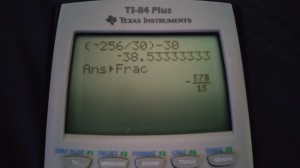Overview
Second order linear equations become homogeneous when the linear function of y and y’ (which can be written in the form y” + p(t)y’ + q(t)y = g(t)) is equal to zero. In other words when g(t)=0.
This guide will be discussing how to solve homogeneous linear second order differential equation with constant coefficient, which is written in the following form:
y”+by’+cy = 0
The first step is to use the equation above to turn the differential equation into a characteristic equation. The characteristic equation is written in the following form:
r2 +br+c = 0
Second to find the roots, or r1 and r2 you can either factor or use the quadratic formula:
r2 = ± -b √b²-4ac
2a
It is important to remember when to the particular equation above. There will problems where the variable a is not needed in the quadratic formula because there will be no a in the differential equation. In the cases where there is no a variable limit the a variable from the quadratic equation. The quadratic equation will the look like the following:
r2 = ± -b √b²-4c
2
Once you get repeated roots , or r1 and r2 from the characteristic equation then y = ert is considered a solution of the differential equation.
The next step would be to plug r1 and r2 into the general equation:
y = C1 er1t +C2 er2t
Another important thing to realize and remember is that when solving a homogeneous equation for a repeated root the solution will end up cancelling out. In order to avoid this a “t” needs to be place in the general solution. The general solution for the repeated root will then be in the following form:
y = C1 er1t +C2t er2t
Sample Problem
Problem 1:
y”+12y’+36 = 0
Step 1: Turn the differential equation into a characteristic equation
r2 + br + c = 0
r2 + 12r + 36 = 0
Step 2: Factor the characteristic equation
r2 + 12r + 36 = 0
(r + 6) (r + 6) = 0
r1 = -6 r2 = -6
Step 3: Use y = ert as a solution for r1 and r2
y = ert
y = e-6t
Step 4: Plug r1 and r2 into the general solution for the repeated roots
y = C1 er1t +C2t er2t
y = ert
y = e-4t
Step 4: Plug r1 and r2 into the general solution for the repeated roots
y = C1 er1t +C2t er2t
y = C1 e-4t +C2t e-4t
y = C1 e-6t +C2t e-6t
Problem 2:
y”+8y’+16 = 0 , y(0) = 2 y’(0)= 6
Step 1: Turn the differential equation into a characteristic equation
r2 + br + c = 0
r2 + 8r + 16 = 0
Step 2: Factor the characteristic equation
r2 + 8r + 16 = 0
(r + 4) (r + 4) = 0
r1 = -4 r2 = -4
Step 3: Use y = ert as a solution for r1 and r2
y = ert
y = e-4t
Step 4: Plug r1 and r2 into the general solution for the repeated roots
y = C1 er1t +C2t er2t
y = C1 e-4t +C2t e-4t
The following three videos are form Khan Academy. I find these videos ever useful . I would recommend you watch them if you are still confused about Repeated Roots of Second order linear homogeneous equation.




